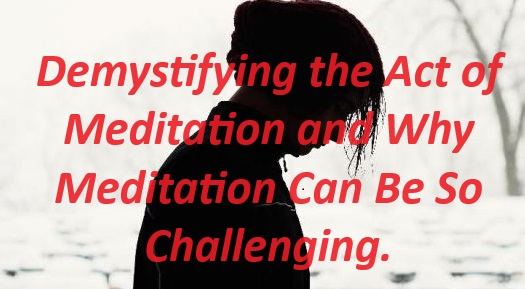Demystifying the Act of Meditation and Why Meditation Can Be So Challenging.

Demystifying the Act of Meditation and Why Meditation Can Be So Challenging.
Like hypnosis, meditation is another way to bypass the critical mind and move into the subconscious system of programs.
The whole purpose of meditation is to move your awareness beyond your analytical mind to take your attention off your outer world, your body, and time and to pay attention to your inner world of thoughts and feelings.
Stigmas surround the word meditation.
Most people conjure up images of a bearded guru on a mountaintop, immune to the elements and sitting in perfect stillness; a monk in a simple robe, his face adorned with a huge, mysterious smile; or even a young and beautiful woman, with flawless skin, on the cover of a magazine, dressed in stylish yoga clothes and looking serenely free from the enslavement of all of the demands of daily life.
When we see these images, many of us might perceive the discipline required as too impractical, too out of reach, and beyond our abilities.
We might see meditation as a spiritual practice that doesn’t fit into our religious beliefs.
Some of us are simply overwhelmed with the seemingly endless varieties of meditation available and are unable to decide where to begin.
But it doesn’t have to be that difficult, “out there,” or confusing.
Let’s just say that the whole purpose of meditation is to move our consciousness beyond the analytical mind and into deeper levels of consciousness.
In meditation, we move not just from the conscious mind to the subconscious mind, but also
- from selfish to selfless,
- from being somebody and someone to being nobody and no one,
- from being a materialist to being an immaterialist,
- from being someplace to being no place,
- from being in time to being in no time,
- from believing that the outer world is reality and defining reality with our senses to believing that the inner world is reality and that once we’re there, we enter “non-sense”: the world of thought beyond the senses.
Meditation takes us
- from survival to creation;
- from separation to connection;
- from imbalance to balance;
- from emergency mode to growth and repair mode;
- from the limiting emotions of fear, anger, and sadness to the expansive emotions of joy, freedom, and love.
We go from clinging to the known to embracing the unknown.
Let’s reason this for a moment.
If your neocortex is the home of your conscious awareness and it’s where you construct thoughts, use analytical reasoning, exercise intellect, and demonstrate rational processes, then you’ll have to move your consciousness beyond (or out of) your neocortex to meditate.
Your consciousness would have to essentially move from your thinking brain into your limbic brain and the subconscious regions.
In other words, for you to dial down your neocortex and all the neural activity that it performs daily, you’d have to stop thinking analytically and vacate the faculties of reason, logic, intellectualizing, forecasting, predicting, and rationalizing at least temporarily.
This is what’s meant by “quieting your mind.”
According to the neuroscientific model that I outlined in the previous chapters, to quiet your mind would mean that you’d have to declare a “cease-fire” on all of the automatic neural networks in your thinking brain that you habitually fire regularly.
That is, you’d have to stop reminding yourself of who you think you are, repeatedly reproducing the same level of mind.
I know that sounds like a huge task that may well be overwhelming, but it turns out that practical, scientifically proven ways exist for us to accomplish this feat and make it a skill.
Why Meditation Can Be So Challenging
The analytical neocortex uses all of the five senses to determine reality.
It’s very preoccupied with putting all of its awareness on the body, the environment, and time.
And if you’re the least bit stressed, then your attention will be directed to and will amplify all three of these elements.
When you’re under the gun of the fight-or-flight emergency system and you switch on your adrenaline, just like any animal threatened in the wild, all of your attention will be placed on taking care of your body, finding escape routes in your environment, and figuring out how much time you have to make it to safety.
You overfocus on problems, obsess about your looks, dwell on your pain, think about how little time you have to do what you need to do, and rush to get things done.
Sound familiar?
Because you’re so hyper-focused on this external world and your problems in it when you’re living in survival, it’s easy to think that what you see and experience is all there is.
And without the external world, you’re no one, nobody, nothing, and in no place.
How frightful that is for an ego that’s trying to control all of its reality by constantly reaffirming an identity!
It might make it easier if you remind yourself that when you’re living in survival, what you sense is truly just the tip of the iceberg, only a limited array of ingredients making up your external world.
You identify with the many variations and combinations in your external world that reflect to you who you think you are but that doesn’t mean there isn’t more.
Every time you learn something new, you change how you see the world.
The world hasn’t changed; only your perception of it has changed.
For now, it’s enough to keep in mind that if your goal is to effect change and you haven’t been able to make it happen with all your external-world resources, then clearly, you’ll need to look outside the limits of what you see, sense, and experience for your answers.
You’ll need to pull from other sources you haven’t yet identified from the unknown.
So, in that sense, the unknown is your friend, not your foe.
It’s the place where the answer lies.
Moreover,
Another reason it becomes difficult for us to pull our attention away from all of the conditions of our outer world and place our attention on our inner world is that most people are addicted to stress hormones to feeling the rush of chemicals that are the result of our conscious or unconscious reactions.
-
-
Also Read: Feeding Your Mind and Spirit
-
This addiction reinforces our belief that our outer world is more real than our inner world.
And our physiology is conditioned to support this, because real threats, problems, and concerns do exist that need our attention.
So, we become addicted to our present external environment.
Through associative memory, we use the problems and conditions in our lives to reaffirm that emotional addiction to remember who we think we are.
Here’s another way to say it:
The stress hormones we experience while living in survival mode give the body a high dose of energy and cause the five senses which plug us into external reality to become heightened.
So naturally, if we’re continuously stressed, we’ll define reality with our senses.
We become materialists.
When we try to go within and connect with the world of “nonsense” and the immaterial, it takes some effort to break our conditioned habit and our addiction to the chemical rush we get from our external reality.
How, then, could we possibly believe that thought is more powerful than physical, three-dimensional reality?
If that’s how we see things, it becomes challenging to change anything by thought alone, because we’ve become enslaved to our bodies and our environments.
Reinforcing new information that shows us that what we think should be impossible is indeed possibly helping us remind ourselves that there’s more to reality than what our senses perceive.
Join Enlighten Knowledge WhatsApp platform.
Join Enlighten Knowledge Telegram platform.








